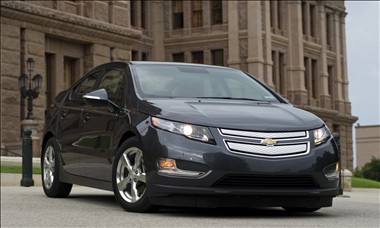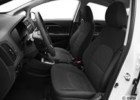Overview:
This week we’re looking again at the 2012 Chevrolet Volt from another point of view: readers know one of my colleagues is automotive engineer Merkel Weiss and no one is more qualified and knowledgeable about the industry. Herewith is a counter point of view on the Chevrolet Volt as it relates to recent issues with the Battery Pack resulting in Fires from crash tests.
This past week, the National Highway Traffic Safety Administration (NHTSA) opened an investigation into battery fires in the Chevrolet Volt, one of the most important cars ever built by General Motors. Important because the Volt takes a fresh technologically innovative approach to electric car design. The car is actually a type of electric/hybrid vehicle in which the electric motor runs the vehicle, powered by a battery pack of Lithium-ion batteries supplied by South Korea’s LG Chem Ltd. When the charge is low, a gasoline engine starts to recharge the battery pack on board. The gasoline engine does not directly power the car, except through the battery pack. This makes it very difficult to assess an equivalent miles per gallon figure for the car, even though it does, at least to some indirect extent, run on gasoline.
My take is that it is intended to be the platform from which GM launches their assault on the coming Corporate Average Fuel Economy (CAFÉ) regulations which currently require some 54.5 mpg by 2025. I’d estimate that even a Cadillac CTS-V Coupe performance car could achieve an equivalent 50 mpg in the EPA city cycle.
The Volt scored quite well in side impact testing at NHTSA. The wrecked car was then examined and stored. Some three weeks later, the car caught fire from within the battery pack so NHTSA engineers tried the test sequence three more times, and on two of these occasions the car caught fire again. Seeing a repeat of the condition that can only be called an internal defect in the battery pack, they issued a safety investigation notice.
General Motors’ immediate response was that the car was completely safe, but if anyone was not satisfied, GM would buy back the car. Sales are relatively few, which is understandable, since it’s a $40,000 Compact car that is nearly experimental. Clearly, the Volt is the most recent GM innovation in a company known for innovation over the years. In recent years, however, GM seems to have fallen behind world standards in engineering and design. Example: most of the world’s prestige brands incorporate direct cylinder fuel injection to their engines in order to keep the cylinder to cylinder combustion as consistent as possible, thereby reducing the exhaust pollution and hence emissions controls necessary to keep the engine within compliance.
You may know the name Tesla, the auto maker, who also has a battery powered car, based on a Lotus Elise, that has a mid-ship battery pack. The car is made by a Silicon Valley company familiar with computer construction where battery packs can sometimes catch fire. Tesla took steps to be confident that the batteries wouldn’t overheat, by incorporating a cooling system that runs around and through the battery pack permitting temperature control. Admittedly, the Tesla Roadster costs $100,000, but I submit that $40K is also a lot of money for the Volt. The point here is that the design engineers at Tesla saw a problem and they designed a system to address that problem and GM did not.
Mary Barra, GM’s global product development chief, says If we have to do something, we will.“There are a few avenues that we think could increase the robustness for this specific condition, and We understand one of the very important premises of the Volt is the EV driving range and we plan to protect that,”
Volt is the most innovative product GM has made since the days of the Chevrolet Corvair, Oldsmobile Toronado, Chevrolet Citation, Pontiac Fiero, and Saturn SL1. It’s a good product for GM, America, and for the industry in general. And while this is a new car, it’s been GMs past history to put their design problems on the street and let the public be their development engineers. Eventually the problems would be fixed alright, but after a time of evaluation, retest, and corrective action.
GM’s market share has slowly eroded from 48.3% in the 1960s to the current level of about 19.3%. Product design flaws may have a lot to do with that decline.
Editors note:
Mr. Weiss makes good points and that may give some reason for you to look twice at GM products. However, the decline in market share has more to do with a global supply of auto products in a “Free Market” giving us cars from countries emerging from the ‘stone age’. And while those countries sell an ever growing number of cars, GM continues to be “Innovative” as Merkel notes.
GM has been putting all their eggs in the Hydrogen powered ‘basket’. It would appear they have realized the challenges of Hydrogen fuel is prohibiting the sale of those 21stCentury cars. Thus it made it necessary to launch some practical innovation while engineers figure out how to make Hydrogen powered cars work. Their Hydrogen car was named the “High Wire” and I test drove it seven years ago at Dodger Stadium in Southern California. My review was with much hope that GM would make it a commercial home run in 5 years as they estimated back then.
I suggest you can’t give up on American ingenuity and GM may yet re-immerge like a Phoenix rising from the ashes and regain their rightful place as the leader in the automotive industry.
Recognized Competition:
Chevrolet Volt $40,000, Chevrolet Malibu Hybrid $ n/a, Ford Fusion Hybrid $29,000, Honda Civic Hybrid $26,000, Honda Insight $20,000, Infiniti M Hybrid $54,000, Lexus CT 200h $29,000, Nissan Altima Hybrid $27,000, Nissan Leaf $33,000, Toyota Camry Hybrid $27,000.
Gas Stats:
$3.51/ Gal avg. December 10, 2011
for more information.
Your comments are welcomed. My e-mail is joe@atthewheel.com
Copyright © 2011 – An Automotive Love Affair





